10 of the Easiest Vegetables to Grow, Even If You Live in Zone 3
Even in zone 3, it’s possible to grow a substantial amount of your own food, especially if you plant the easiest vegetables to grow. The season is shorter. If you live in the mountains you might not get the heat units necessary for corn, squash, or pumpkin. But you can definitely get a harvest with these ten easy to grow vegetables.
In zone 3 you want to get an early start because you might only have 60 to 75 frost-free days. Plant in raised beds and use row covers to extend your growing season. Here in the mountains of British Columbia, our last frost date is around the middle of June, but we plant many vegetables as early as the end of April, using heavy row covers to beat the frost.

The 10 easiest vegetables to grow (in planting order)
In my experience, these 10 vegetables are the easiest vegetables to grow if you live in zone 3 to 7. You can plant them in containers if you don’t have a backyard garden. They will grow well in raised beds, too. I’ve listed these plants in the order that you can plant them from April to mid-summer.
Peas
Peas are one of the easiest vegetables to grow and are loved by child gardeners, too, because they grow so quickly. Peas can be planted as soon as the ground can be worked in the spring, around April 15th here in the mountains. I plant peas in raised beds so that they don’t have to sit in water, as the snow melts. As soon as soil temperatures get around 45 degrees peas will germinate. Peas will emerge in 2 to 4 weeks at soil temperatures between 40 and 50°F. At 60°F peas will germinate in only 9 to 13 days. It’s certainly fine to wait till soil temperatures are warming before planting peas.
Sometimes in zone 3 gardens, the spring can be cold and wet and soil temperatures don’t warm up. Peas can still be grown successfully. Peas are one of the easiest vegetables to grow in colder climates.

You can sometimes get a second crop of peas by planting peas again in the first week of August when nighttime temperatures cool down.
Pea shoots are edible. Even if the fall crop doesn’t mature because of preemptive cool temperatures, the shoots can be added to stir-fries or steamed as a vegetable that tastes just like fresh garden peas.
You can choose between snow peas and snap peas with their edible pods or traditional shelling peas. For space, you’ll get a bigger harvest from snow peas because they are picked at the immature stage when the peas are barely visible in the pod. Provided you keep the vines well picked you’ll see a harvest of 3 to 4 weeks before the vines die back in July.
Potatoes
Potatoes are the set ‘em, forget ‘em easy vegetable to grow. Plant them in trenches and bury them with soil and then mulch them well with straw or 3rd cut hay. Potatoes are frost hardy once they are trenched in. When hit by a late frost, the tops will die back, but they’ll regrow from the root as soon as the temperatures return to normal.
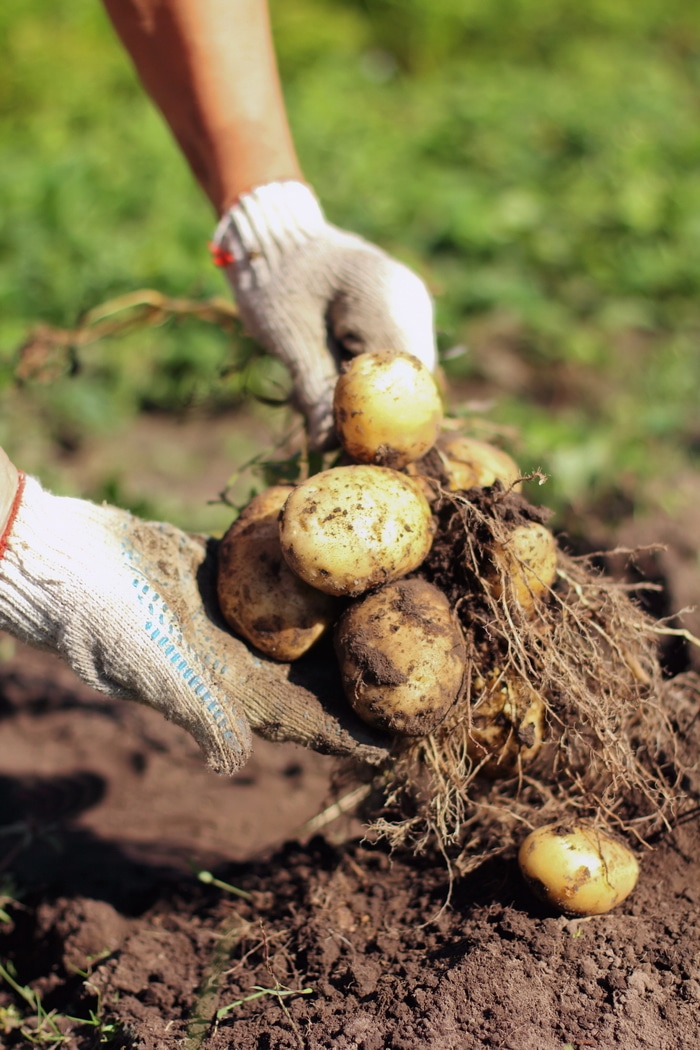
Choose certified disease-free seed potatoes from the garden store. Don’t plant grocery store potatoes. Many grocery store potatoes are treated to keep them from sprouting. Grocery store potatoes might bring soil-borne diseases to your garden, so opt for the seed potatoes for long-term success.
Plant potatoes as soon as the soil is 40°F, about the time you see the first pea sprouts in your garden. Keep them well mulched so they don’t dry out. Around the middle of July, the top will flower. About a week later you can gently dig around the plants, without disturbing them and harvest a few spuds for spring eating. If you live in an area that is troubled by potato beetle, potatoes may be covered with a heavy row cover like this one to protect them from the beetles.
Potatoes take 70 to 120 days till they are ready to harvest, depending on the variety. Wait till the vines die back in late August to mid-September before harvesting. Plan to harvest them on a dry day to prevent spoilage in storage.
Lettuce
I plant lettuce thickly in a section of a raised bed for cut and come again salad greens, like the expensive spring mix sold in the plastic clamshell packs at the grocery store. You don’t need much space for lettuce when planting this way. You’ll get at least 3 cuttings of the lettuce crop before you’ll need to take it out and replant it.
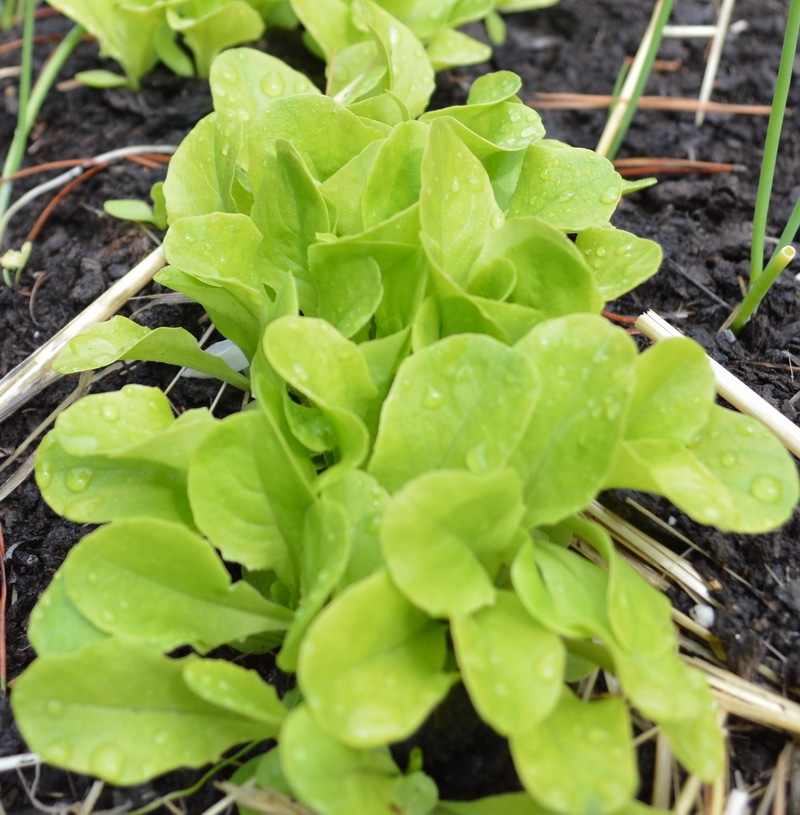
Prepare a raised bed garden by removing all weeds. Amend the soil with finished compost. Sprinkle a seed mixture of red and green lettuces, kale, and other baby greens, recommended for your zone. Most garden catalogues have a selection of different mescalin mixes for different times during the growing season.
Lettuce is a cool-season crop. In areas where the temperature rises quickly after June first, you’ll plant different varieties than I plant in zone 3, with my cooler night temperatures.
Once the lettuce is 3 inches high, before the first cutting, you can transplant some of the emergent baby lettuces to another spot in rows. This allows both cut and come again harvests immediately and a later season harvest of mature lettuce heads.
Radishes
Radishes are a favourite garden plant for children. They are fast-growing and each seed makes one radish. Plant them one inch apart when the soil temperatures are 45°F., at the same time as you are planting potatoes and peas. They will germinate in 3 to 7 days. They’ll be ready to harvest in 30 days. You can plant them again after harvesting.

Swiss Chard
Swiss chard is a hardy vegetable that can be harvested over and over again from a single planting. Plant chard about 3 weeks before your last expected frost date, in rows 2 inches apart and half an inch deep. Chard germinates in five to seven days when soil temperatures are 40 ° to 90°F. Chard seeds are actually a bundle of seeds and will produce more than one plant. These will require thinning in the row to allow for 6 to 12 inches between plants as a final spacing.
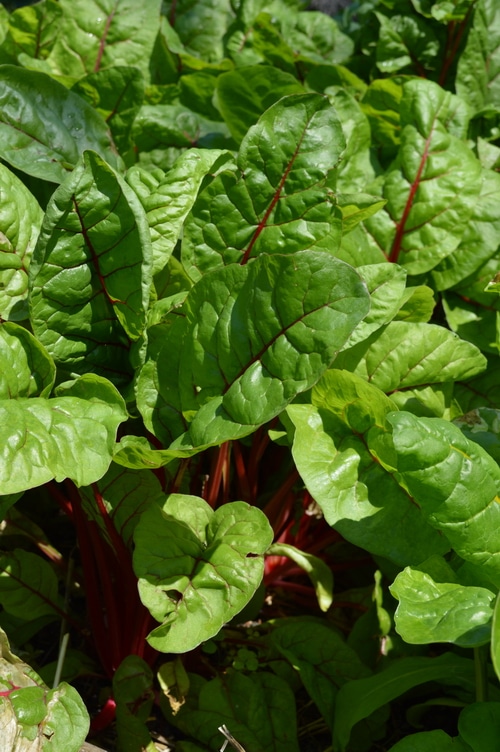
Harvest chard by removing the outermost leaves. Fresh leaves will continue to grow throughout the growing season until the plants are killed by a “killing frost”. If the leaves seem too tough, you can renew the plant by cutting off all the leaves about four inches above the ground level. The plant will renew its leaf production with soft, tender leaves.
Kale
Kale can be treated like a cut and come again tender baby green or it can be planted for mature leaf harvest. The difference is in how close together the plants are planted. Kale can be planted about 3 weeks before your last frost day when soil temperatures are at least 45°F. The seed germinates in 4 to 7 days. Plant Kale 1 inch apart in rows that are 18 inches apart. Thin the plants to 12 to 18 inches apart for optimal growth.
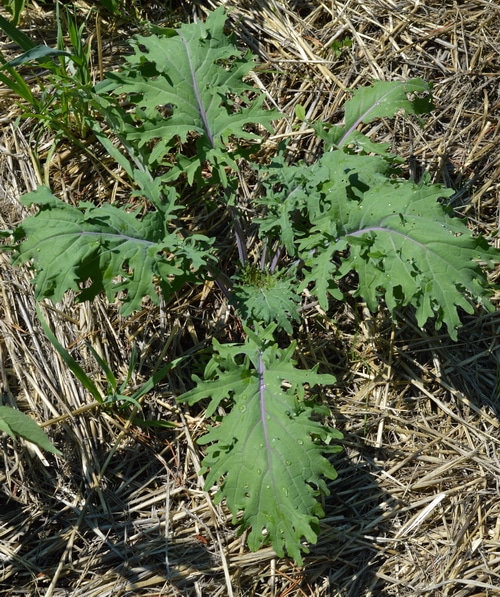
For baby leaf production, kale can be left at 1 inch apart, and harvested two or three times before the plants will need to be replanted with fresh seed. Harvest individual leaves during the growing season beginning at the bottom of the plants.
Carrots
Carrots are one of the easiest vegetables to grow once you have good germination. The secret is to keep the seeds moist during the few days it takes to germinate them. Carrots can be planted any time after your peas have emerged and soil temperatures are above 45°F. Carrots are easy to grow in zone 3 because they aren’t stunted by lower temperatures and can withstand light frost. Plant carrots that take 75 to 95 days to mature. You’ll plant them in the early spring and harvest them in late August or early September in zone 3 before the ground has frozen.
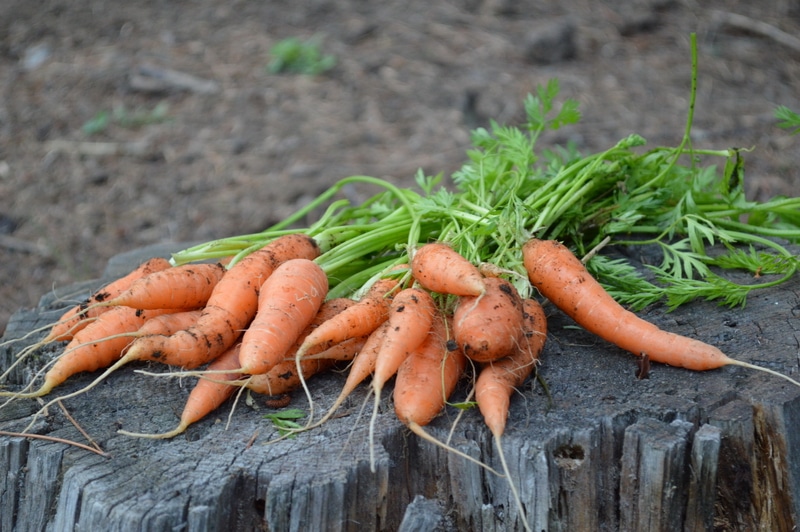
You’ll want to plant them in a raised bed that has been worked to a fine tilth. Get rid of any rocks you find. The rocks will deform the roots of the carrots, causing forking. Tap the earth down and make a shallow furrow no more than ¼ inch deep. Mix your carrot seed with twice as much sand as seed, to help with spacing the seed. Sprinkle the seed into the furrow. Cover with a light dusting of soil. Moisten the row with a fine spray of water. Cover this with a burlap sack to keep the moisture in the seed. The carrots will germinate in soil temperatures of 45 to 80°F. After 2 weeks, check to see if the carrots have leaves. If they do remove the burlap. If they don’t, wait and inspect them again in a week’s time.
Carrots are ready to harvest when the central stem of the leafy top thickens and the roots are as long as the seed package says they will grow. This may vary depending on your climate and the number of days above freezing you’ve experienced in the season.
Beets
Beets are another hardy vegetable from the same family as Swiss chard and spinach. All the vegetables in the beet family are cold hardy and easy to grow. Beets produce both roots and leafy greens. They germinate when soil temperatures are 50 to 85°F. While they will germinate when soil temperatures are 40°F, beets that are chilled in their early development may not produce full-size roots. It’s better to wait until soil temperatures have warmed up before planting. I plant beets here about 2 weeks before my last frost day and about a week after I plant carrots. I cover them with a row cover to prevent chill if the nights should dip below freezing.
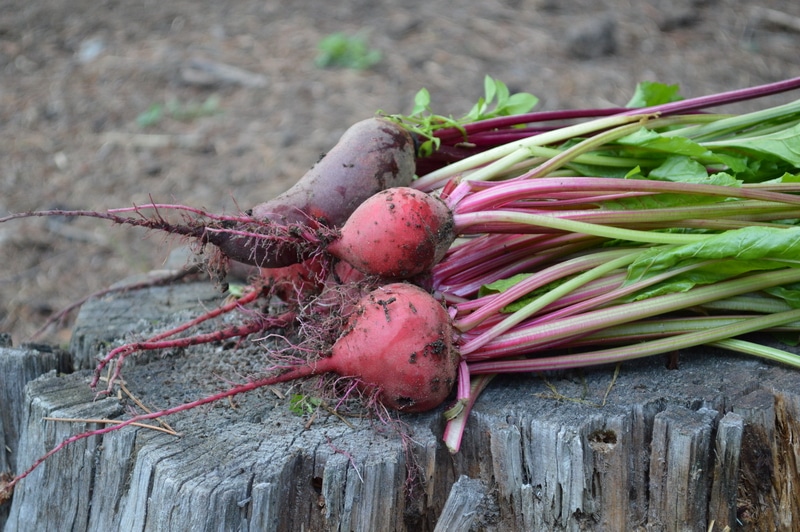
Plant beet seeds ¾ inch deep, about 1 inch apart in rows that are 12 inches apart. The seeds will germinate in 5 to 8 days. Each beet seed is actually a cluster of seeds. You’ll need to thin the seedlings to 4 to 6-inch spacing once the plants are 4 inches high. Keep beets mulch to control weeds and keep the plants evenly moist, which prevents zoning in the beetroot.
Unlike some root vegetables, beets take well to transplanting. So if you really like beets, you can transplant the thinnings into a garden spot that previously held radishes earlier in the season.
Bok Choy
Bok choy is a hardy annual from the same plant family as kale, another easy to grow vegetable, though they look nothing alike. Bok Choy germinates when soil temperatures are between 50 and 80°F. Plant bok choy 8 to 12 inches apart in rows 18 to 30 inches apart. While bok choy can handle a little frost, nighttime temperatures below 50°F for a week or more will cause the plants to bolt into flower, when warm temperatures return.
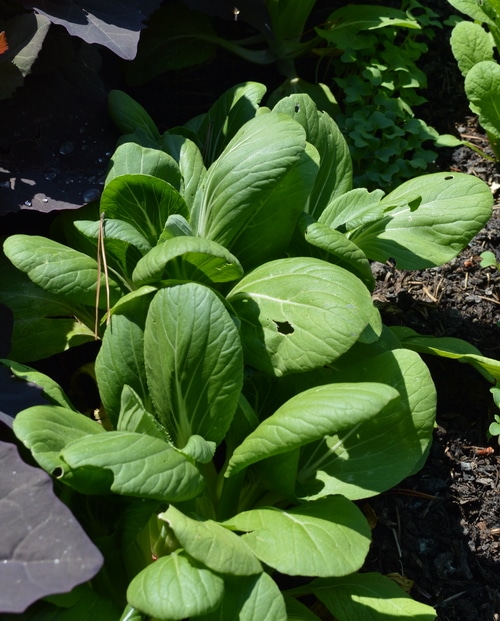
Wait until your last frost date to direct seed bok choy into the garden or cover the plants with a heavy row cover like this one to protect the young plants.
Harvest bok choy by cutting off the plant just above the crown. New plants may regrow from the crown if it is left in the soil, giving you a second harvest of smaller leaves.
Zucchini
Once frost is past, zucchini is one of the easiest vegetables to grow in the garden. It needs soil temperatures of 65°F to 70°F for strong germination. The seed should germinate within 4 to 7 days. In short-season areas begin the zucchini indoors in coir pots and plant out after the last frost date. In my area, I plant zucchini in raised beds and cover the plants with a heavy row cover to protect them from cooler night temperatures. The row cover should be held above the plants to allow for good air circulation and protect against powdery mildew. Once flowering begins remove the row cover during the day to allow for pollination.
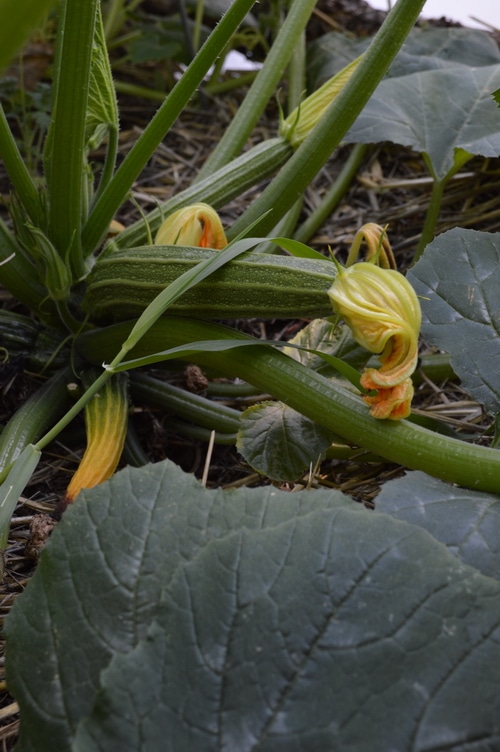
Zucchini vines are compact and have a spread of 3 to 4 feet. 4 plants give my family enough zucchini to share with neighbours, even in my cooler summers. Pick the fruit when it is small and tender before the seed forms.
Grow these easy to grow vegetables in containers
These easy to grow vegetables are even easier to grow in containers if you don’t have a garden to call your own yet. Don’t let a lack of land keep you from raising your own food. Use a container that is at least 5 inches deep for lettuce, chard, kale, bok choy, and radishes. A 10-inch pot is sufficient for carrots, and beets. A large 12-inch pot will hold a zucchini plant. Peas are shallow-rooted but the vines are tall and might upset a lightweight planter, so plan to place peas in a 10 or 12-inch plant for stability. Since peas are nitrogen fixers you can plant them close in the pot. They are shallow-rooted so you can add other deeper rooted plants, like carrots in the same pot with peas. The peas will feed the other plants rather than stealing fertility from them.
You can grow potatoes in deep pots that are at least 10 to 12 inches deep. Some people grow potatoes in bags. Have a look at these instructions for growing potatoes in bags over on Preparedness Mama. Don’t let the plants dry out completely and you’ll be able to harvest them early. Container-grown potatoes often mature earlier than potatoes grown in the ground.
How to extend the season in short-season zone 3 gardens
You may not succeed in extending the season by planting earlier outside. Seeds are programmed to begin growing based on soil temperatures and hours of sunlight. But you can extend the season in two ways. The first is by starting plants indoors under a grow light and transplanting them in their optimal position after all danger of frost has passed. This can give you a jump start on the growing season that can be especially helpful in short-season gardens.
The second way to extend the season, even if you are planting easy to grow vegetables, is to cover the raised beds with a row cover. This protects the plants against both late and early frosts and can hold heat and moisture in the soil.
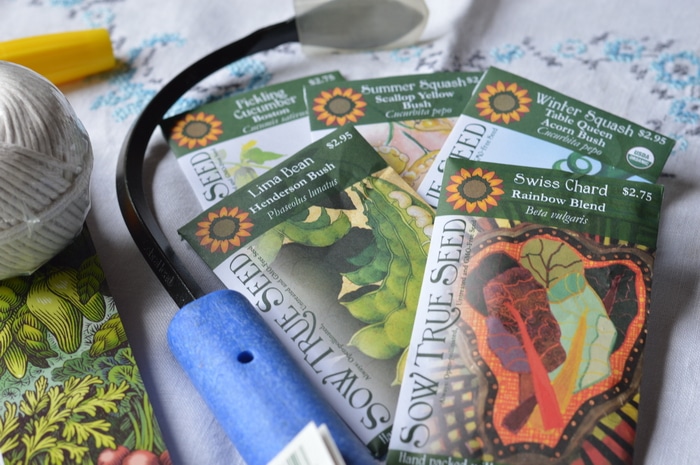
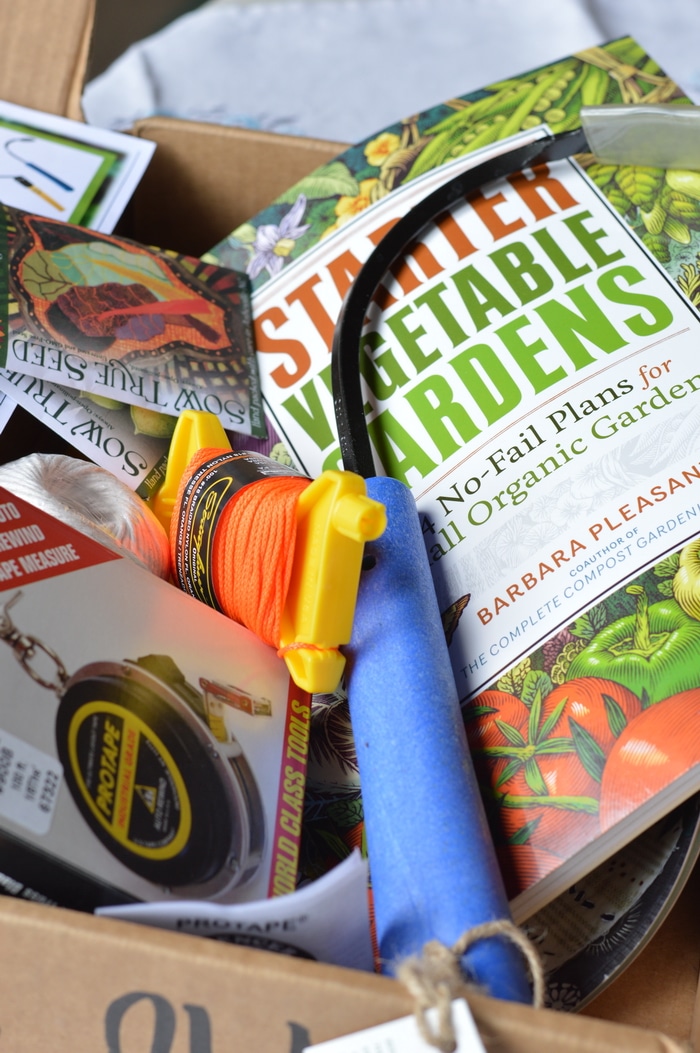
Your Turn:
Which of these easy to grow vegetables will you plant in your garden?



This is a very good tip especially to those new to the blogosphere.
Short but very accurate information… Thank you for sharing this one.
A must read post!